The iPad Air Review
by Anand Lal Shimpi on October 29, 2013 9:00 PM ESTiPhone to iPad: CPU Changes
Although the iPad Air uses the same A7 from the iPhone 5s (and M7 motion coprocessor), there are a few minor differences that do lead to better performance.
At a high level we’re still talking about two 64-bit Apple Cyclone cores with 128KB L1s (64KB I$ + 64KB D$) per core, a shared 1MB L2 cache and a 4MB L3 cache that services the entire SoC. Apple increased CPU frequency from 1.3GHz to 1.4GHz in the iPad Air, a mild increase but in line with what we’ve seen from previous iPad designs. That’s the first impact on performance - a 7.69% increase in CPU frequency.
The second impact on performance is something I only noticed while digging around under the hood of the A7. It seems like the implementation in the iPad Air can, for whatever reason, hold more instructions in flight (over 20% more) than the A7 in the iPhone 5s. It’s unclear to me whether the A7 in the iPad is configured any differently via firmware/microcode or if perhaps we’re looking at a slightly different revision of the core, but the delta was repeatable in my testing.
The third, and likely biggest change impacting the iPad Air’s implementation of the A7 is the additional thermal headroom afforded by the larger chassis. I’m not going to go into details on exactly what this next test does (unfortunately we’re going to occlude some of the low level work that we do in light of all of the benchmark cheating going on), but we’re looking at a curve of performance vs. time for a particularly power heavy mix of code. We’re running the same exact code on both the iPad Air and iPhone 5s here, the only real difference is the size of the chassis:
You can see the 5s throttles back its CPU frequency to about 1GHz after the 2 minute mark. The crazy thing is that until that point the 5s manages to run at full frequency without so much as a hiccup for two full minutes, running an incredibly power hungry task. Given that most iOS apps aren’t this power intensive for such a sustained period of time, iPhone 5s users should almost always see the A7 running at a full 1.3GHz. Pretty crazy.
The iPad Air by comparison shows much more controlled behavior. Early on in the test we see a 7.7% performance advantage, which lines up perfectly with the iPad Air’s 7.7% CPU frequency advantage. By the end of the test the iPhone 5s has throttled to 900MHz, while the iPad Air drops to around 1.2GHz. At this point the iPad Air’s performance advantage grows to almost 40%.
CPU Performance
I've gone through our standard set of cross-platform browser based benchmarks to place the iPad Air's performance in perspective. As I mentioned in our 5s review, I don't know that there are many (any?) applications on iOS 7 that can really take advantage of all the A7 has to offer. There's definitely a ton of headroom left in the design. What's particularly exciting is when the A7 ends up in n-1 or n-2 iOS devices and it becomes the minimum developer target going forward.
I won't go through all of the results here again, but it's safe to say that the iPad Air is the fastest ARM based tablet on the planet at this point.
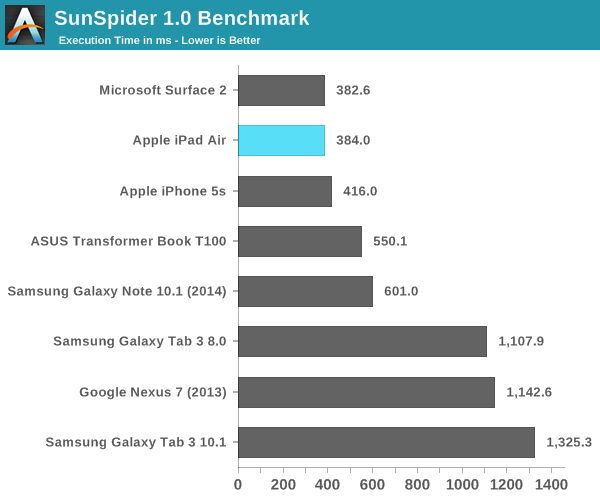
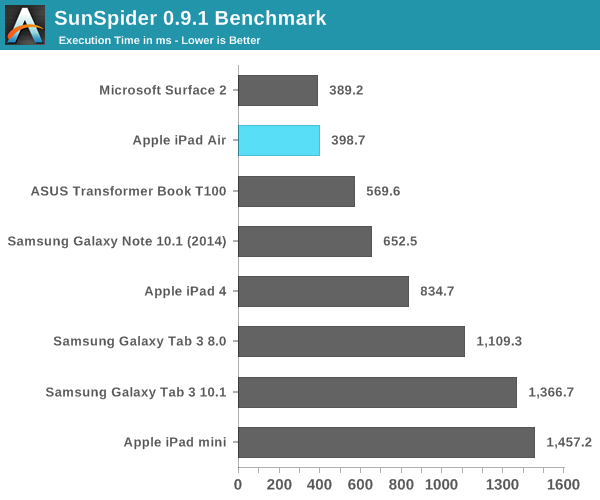
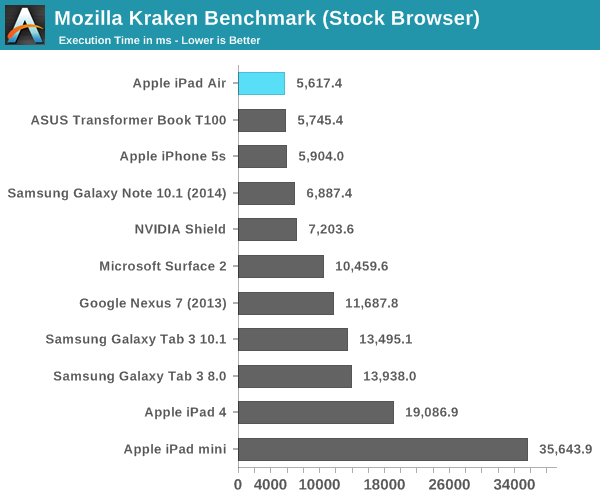
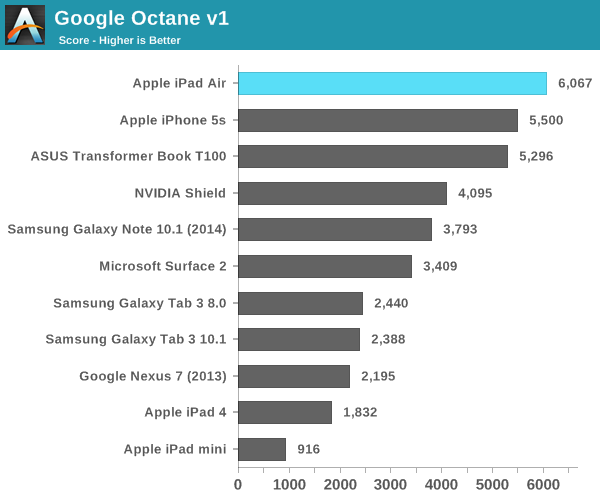
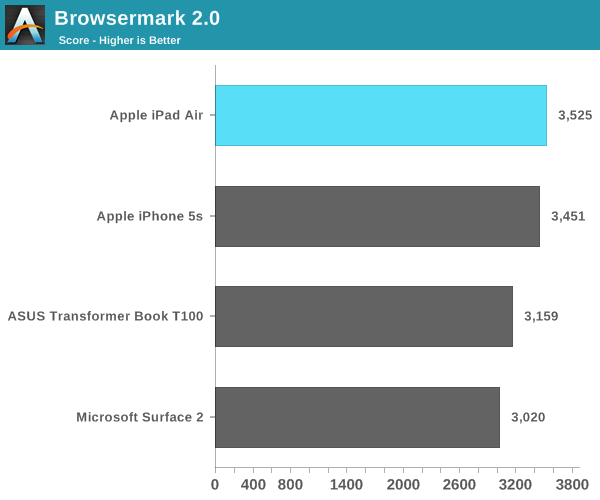

A7 Power Consumption
I’ll get to battery life in a bit, but I’ve been curious about the dynamic range of power consumption offered by Apple’s new A7 SoC. On the one hand we’re dealing with a lower power process (28nm vs. 32nm), but on the other hand Apple’s Cyclone cores can clearly draw more power given how beefy the architecture is this round. Apple frowns upon review sample dissection so I had to turn to a less scientific method of external platform level power measurement. The fidelity of the numbers here aren’t all that great but it’s better than nothing.
For the first test I measured platform power consumption during a Kraken run:
I purposely started measuring before the benchmark so I could get an idea of idle power consumption. The iPad Air consumes roughly 72% of the idle power as the iPad 4, both running at the same brightness. Here we’re not just seeing the A7’s advantages but also things like lower display power.
Focusing on the load portion of the measurement we see that both the new iPad and old iPad consume the same total power in this test. I suspect the A7 is drawing more power than the A6X, but it’s masked by a lower power display. Given how much faster the iPad Air is, Apple’s latest tablet features far lower overall task energy than the outgoing iPad 4. This is probably both the best case scenario for the iPad Air and the most likely case as well.
For kicks I wanted to see just how much power I could get the iPad Air to draw. Here I’m looking at platform power during our mini-power-virus test from above:
How’s that for dynamic range? Almost 12W running all out, but around half that in what we’d normally consider to be a stressful CPU test. I couldn’t get any actual applications/games on the iPad Air to behave like this so the results above are purely academic (for now). A quick run through GFXBench 2.7’s T-Rex HD test confirms that even pushing the GPU won’t hit these numbers. The max I saw running T-Rex offscreen was ~6W, and turning to an actual game (Infinity Blade 3) the iPad Air pulls less than 5W.


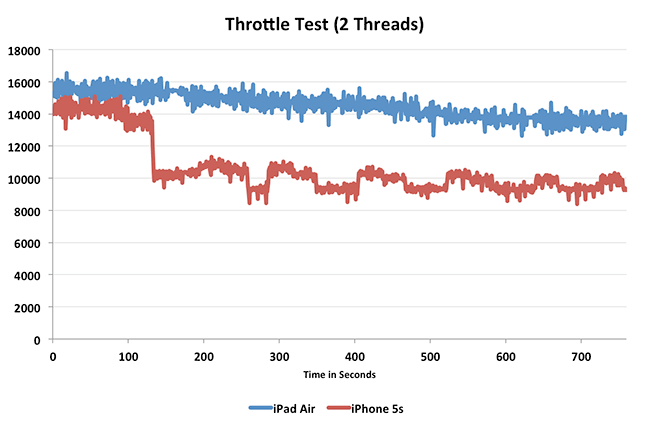
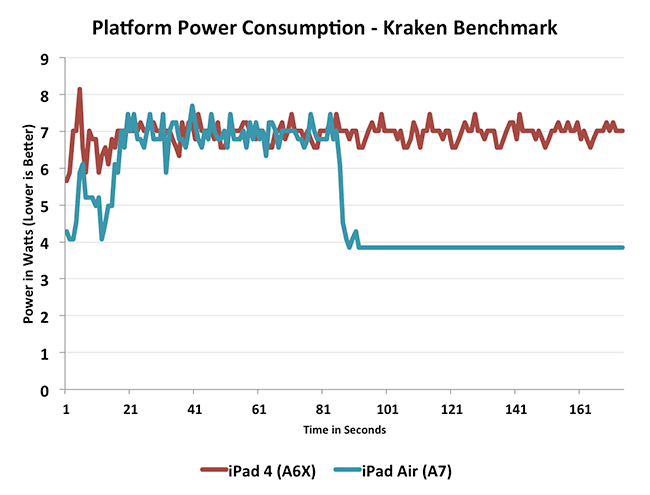
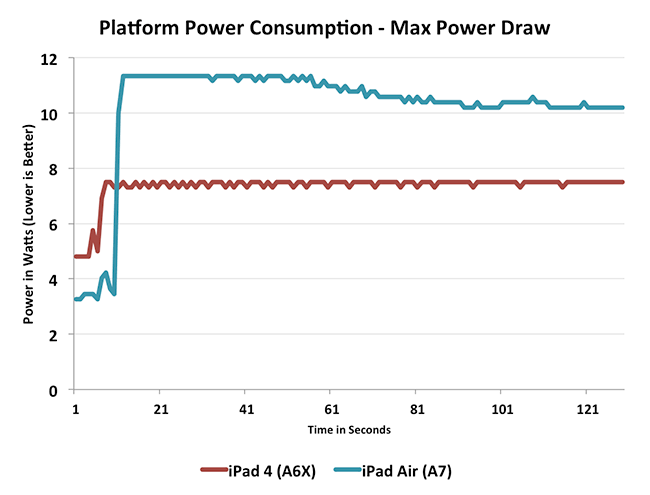








444 Comments
View All Comments
Ryan Smith - Wednesday, October 30, 2013 - link
Which is the difference between having me do something, and having Anand do something. There is a very good reason he's The Boss, after all. He's a machine (figuratively speaking).;-)Krysto - Wednesday, October 30, 2013 - link
> A single CPU core can use up 8GB/s of bandwidth. I’m still vetting other SoCs, but so far I haven’t come across anyone in the ARM camp that can compete with what Apple has built here.Didn't Exynos 5250 have 17.5 GB/s bandwidth, according to Samsung's whitepaper? That would be more than 8GB/s per core.
raptorious - Wednesday, October 30, 2013 - link
Maybe if you're talking about L1 or L2 bandwidth, but not DRAM. The DRAM interface on that chip is 2x32 bit and it's clocked at DDR3-1600, which means it can reach a _peak theoretical max_ of 12.8 GB/s. Theoretical bandwidth is one thing, what the CPU can actually sustain to DRAM is a whole different story.AbbyYen - Wednesday, October 30, 2013 - link
the SHIELD is A BEAST!well done NVIDIA, now made it into tablet form with those battery. I don't care if it is a cylinder type, protrude the tablet if you have to so it won't lay flat on table and won't need no magic cover!
iPad for leisure only, play and usefulness is still Android!
darkcrayon - Wednesday, October 30, 2013 - link
Shield is much lower resolution, obviously. Remember also the iPad is (finally) getting official physical controller support, which makes it a potentially much more versatile device than the Shield. And clearly iOS is no slouch when it comes to developer support for games. About the only thing nvidia has here is the willingness to pay for more exclusives. How many people do you think would get a general purpose iPad and use it for awesome games vs buying a one-trick pony like the Shield?ddriver - Wednesday, October 30, 2013 - link
LOL, this is a new high (or low) in manipulative reviews, so now the A7 is faster than a Haswell? With all the money AT pockets in, one would thing they'd at least write a set of in-house REAL CPU benchmarks, especially after all the b1tching about manufacturers cheating in the 3rd party benchmarks that are widely available...Wilco1 - Wednesday, October 30, 2013 - link
It's not as unlikely as you think. An old Cortex-A9 gets half the performance of SB on SPECINT, and A15 is much closer still. Apple's A7 is even wider so should be able to beat a low clocked Haswell. That doesn't mean it can beat the 4GHz beasts - for that Apple would need to clock their A7 much higher and increase core counts, and that is unlikely for now.However I fully agree with you on Anand's state of benchmarks. That he still keeps using SunSpider (one of the most cheated on benchmarks) while at the same time talking about frequency changes as cheating is beyond me. And the claim of A7 being 6-wide is very dubious, it seems to me it's 4-way - it hasn't that much higher IPC than an A15.
thunng8 - Wednesday, October 30, 2013 - link
Not much lower IPC? You've got to be kidding right?A 1.9ghz A15 scores 920 in single core geekbench
A 1.3ghz Apple A7 scores 1400.
IPC looks to be about double on the Apple A7. In what world is double preset close.
Your assertion that deliberately changing frequency when detecting benchmark is not cheating is laughable.
Wilco1 - Wednesday, October 30, 2013 - link
Actually he 64-bit score includes hardware acceleration of crypto functions which artificially inflate the score. The 32-bit integer score is 1065 for 1.3GHz A7 vs 895 for 1.6GHz 5410. That's about 46% IPC gain, or just one generation. A57 will have almost the same IPC as A7, and is still 3-way OoO.Your idea that running a CPU at its designed maximum frequency is cheating is ridiculous. Ever done any benchmarking? I think not. The first thing you do when benchmarking is disable DVFS so you get meaningful and repeatable results at the maximum frequency.
errorr - Wednesday, October 30, 2013 - link
But how does that make benchmarks worthwhile if DVFS is disabled? I want to know if an aggressive throttle is applied in situations. If the DVFS table throttles in the middle of a benchmark the problem is the table.This just shows where ARM needs the most help compared to the other players. Intel and AMD are way ahead in power managment and the newer graphics even throttle much more intelligently, quicker, and with better granularity than any ARM chip. This is one of the last low hanging fruits in performance for such power limited chips. On die voltage regulation is a must for future generations.